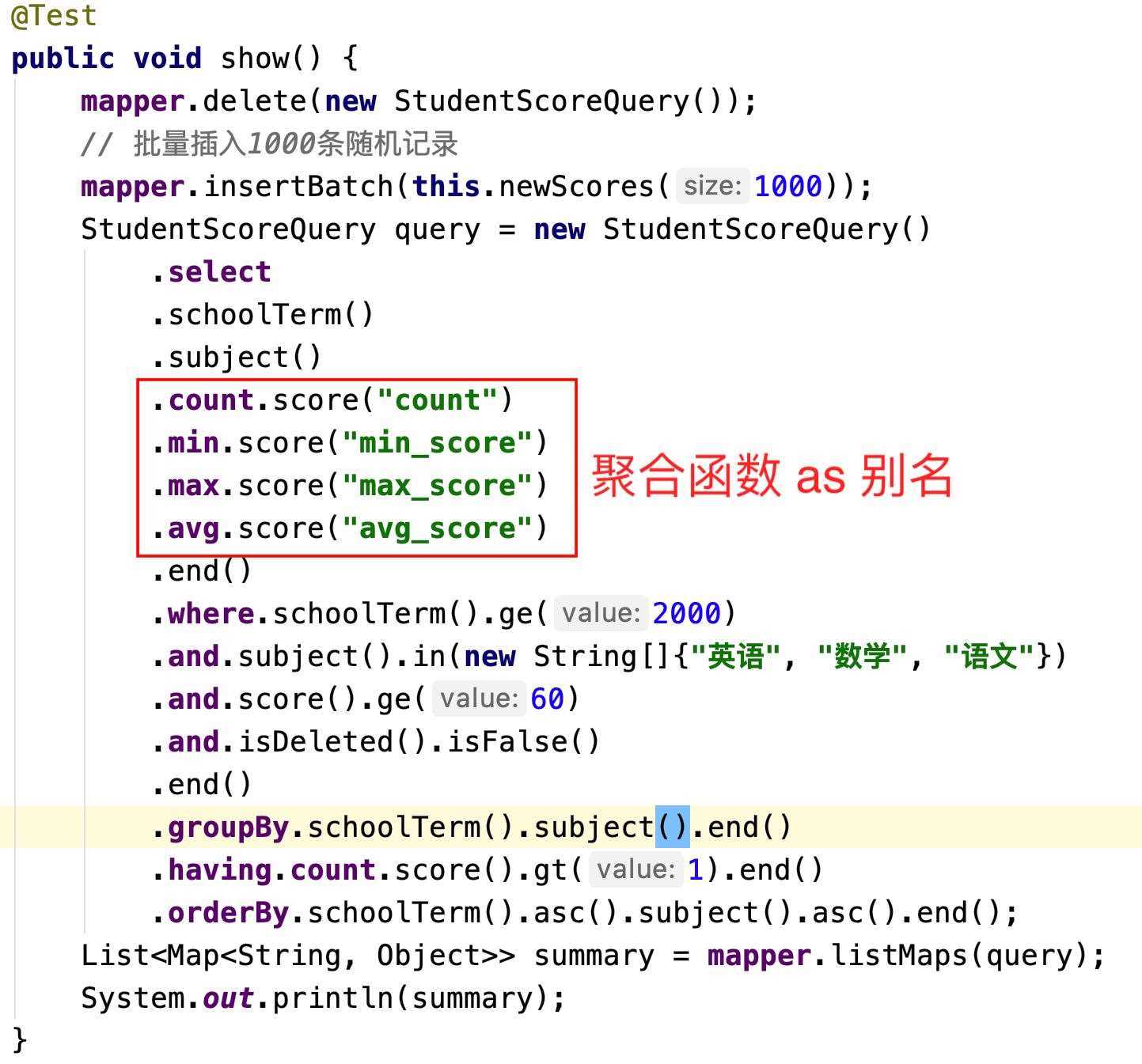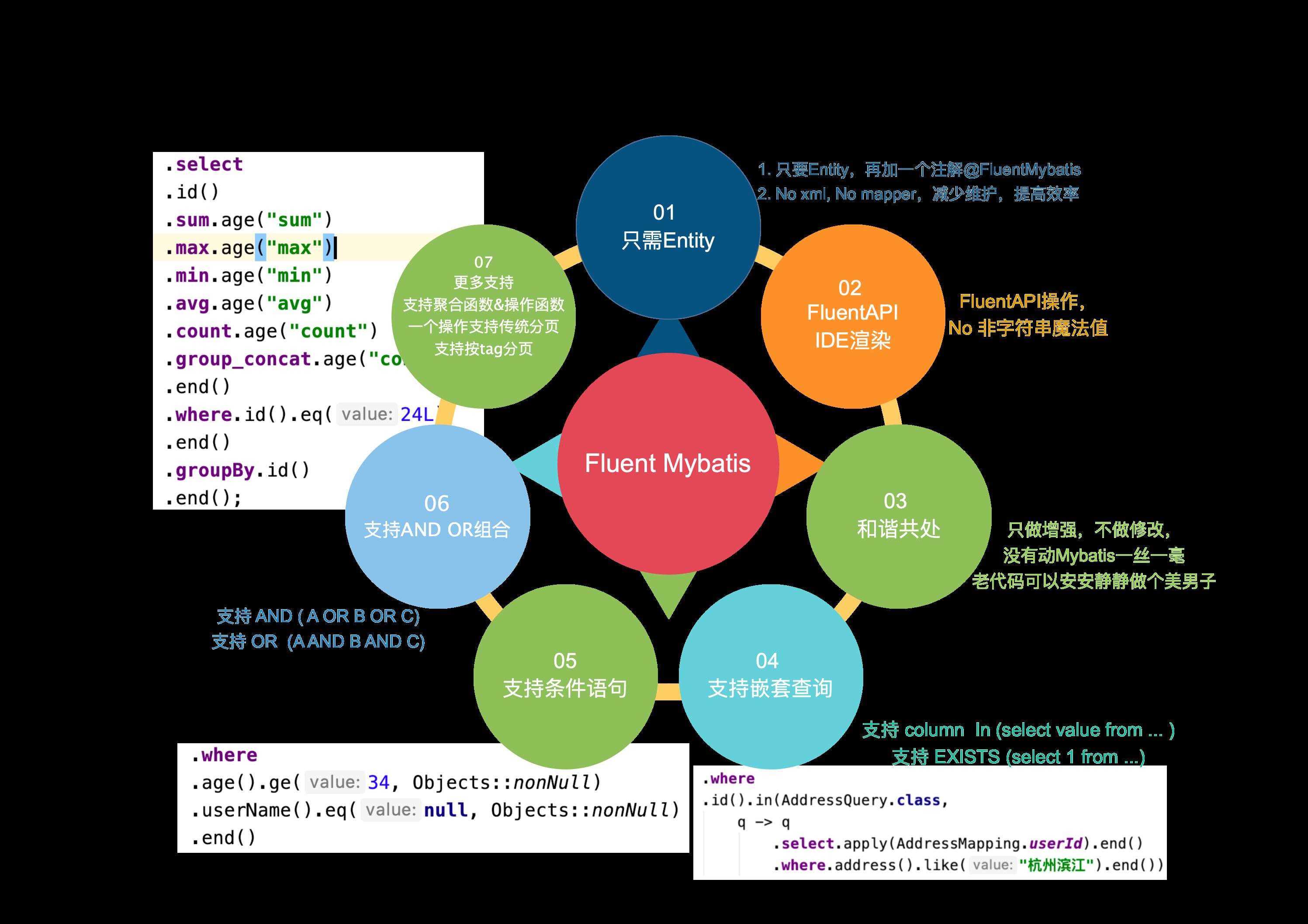Fluent Mybatis,原生Mybatis,Mybatis Plus三者功能對比
使用fluent mybatis可以不用寫具體的xml文件,通過java api可以構造出比較復雜的業務sql語句,做到代碼邏輯和sql邏輯的合一。不用再需要在Dao中組裝查詢或更新操作,在xml或mapper中再組裝次參數。那對比原生Mybatis, Mybatis Plus或者其他框架,FluentMybatis提供了哪些便利呢?
我們通過一個比較典型的業務需求來具體實現和對比下,假如有學生成績表結構如下:
create table `student_score`( id bigint auto_increment comment ’主鍵ID’ primary key, student_id bigint not null comment ’學號’, gender_man tinyint default 0 not null comment ’性別, 0:女; 1:男’, school_term int null comment ’學期’, subject varchar(30) null comment ’學科’, scoreint null comment ’成績’, gmt_create datetime not null comment ’記錄創建時間’, gmt_modified datetime not null comment ’記錄最后修改時間’, is_deleted tinyint default 0 not null comment ’邏輯刪除標識’) engine = InnoDB default charset=utf8;
現在有需求:統計2000年三門學科(‘英語’, ‘數學’, ‘語文’)及格分數按學期,學科統計最低分,最高分和平均分,且樣本數需要大于1條,統計結果按學期和學科排序我們可以寫SQL語句如下
select school_term, subject, count(score) as count, min(score) as min_score, max(score) as max_score, avg(score) as max_scorefrom student_scorewhere school_term >= 2000 and subject in (’英語’, ’數學’, ’語文’) and score >= 60 and is_deleted = 0group by school_term, subjecthaving count(score) > 1order by school_term, subject;
那上面的需求,分別用fluent mybatis, 原生mybatis 和 Mybatis plus來實現一番。
三者實現對比使用fluent mybatis 來實現上面的功能
具體代碼
我們可以看到fluent api的能力,以及IDE對代碼的渲染效果。
換成mybatis原生實現效果定義Mapper接口
public interface MyStudentScoreMapper { List<Map<String, Object>> summaryScore(SummaryQuery paras);}
定義接口需要用到的參數實體 SummaryQuery
@Data@Accessors(chain = true)public class SummaryQuery { private Integer schoolTerm; private List<String> subjects; private Integer score; private Integer minCount;}
定義實現業務邏輯的mapper xml文件
<select resultType='map' parameterType='cn.org.fluent.mybatis.springboot.demo.mapper.SummaryQuery'> select school_term, subject, count(score) as count, min(score) as min_score, max(score) as max_score, avg(score) as max_score from student_score where school_term >= #{schoolTerm} and subject in <foreach collection='subjects' item='item' open='(' close=')' separator=','>#{item} </foreach> and score >= #{score} and is_deleted = 0 group by school_term, subject having count(score) > #{minCount} order by school_term, subject</select>
實現業務接口(這里是測試類, 實際應用中應該對應Dao類)
@RunWith(SpringRunner.class)@SpringBootTest(classes = QuickStartApplication.class)public class MybatisDemo { @Autowired private MyStudentScoreMapper mapper; @Test public void mybatis_demo() {// 構造查詢參數SummaryQuery paras = new SummaryQuery() .setSchoolTerm(2000) .setSubjects(Arrays.asList('英語', '數學', '語文')) .setScore(60) .setMinCount(1);List<Map<String, Object>> summary = mapper.summaryScore(paras);System.out.println(summary); }}
總之,直接使用mybatis,實現步驟還是相當的繁瑣,效率太低。那換成mybatis plus的效果怎樣呢?
換成mybatis plus實現效果mybatis plus的實現比mybatis會簡單比較多,實現效果如下

但正如紅框圈出的,寫mybatis plus實現用到了比較多字符串的硬編碼(可以用Entity的get lambda方法部分代替字符串編碼)。字符串的硬編碼,會給開發同學造成不小的使用門檻,個人覺的主要有2點:
字段名稱的記憶和敲碼困難 Entity屬性跟隨數據庫字段發生變更后的運行時錯誤其他框架,比如TkMybatis在封裝和易用性上比mybatis plus要弱,就不再比較了。
生成代碼編碼比較fluent mybatis生成代碼設置public class AppEntityGenerator { static final String url = 'jdbc:mysql://localhost:3306/fluent_mybatis_demo?useSSL=false&useUnicode=true&characterEncoding=utf-8'; public static void main(String[] args) {FileGenerator.build(Abc.class); } @Tables(/** 數據庫連接信息 **/url = url, username = 'root', password = 'password',/** Entity類parent package路徑 **/basePack = 'cn.org.fluent.mybatis.springboot.demo',/** Entity代碼源目錄 **/srcDir = 'spring-boot-demo/src/main/java',/** Dao代碼源目錄 **/daoDir = 'spring-boot-demo/src/main/java',/** 如果表定義記錄創建,記錄修改,邏輯刪除字段 **/gmtCreated = 'gmt_create', gmtModified = 'gmt_modified', logicDeleted = 'is_deleted',/** 需要生成文件的表 ( 表名稱:對應的Entity名稱 ) **/tables = @Table(value = {'student_score'}) ) static class Abc { }}mybatis plus代碼生成設置
public class CodeGenerator { static String dbUrl = 'jdbc:mysql://localhost:3306/fluent_mybatis_demo?useSSL=false&useUnicode=true&characterEncoding=utf-8'; @Test public void generateCode() {GlobalConfig config = new GlobalConfig();DataSourceConfig dataSourceConfig = new DataSourceConfig();dataSourceConfig.setDbType(DbType.MYSQL) .setUrl(dbUrl) .setUsername('root') .setPassword('password') .setDriverName(Driver.class.getName());StrategyConfig strategyConfig = new StrategyConfig();strategyConfig .setCapitalMode(true) .setEntityLombokModel(false) .setNaming(NamingStrategy.underline_to_camel) .setColumnNaming(NamingStrategy.underline_to_camel) .setEntityTableFieldAnnotationEnable(true) .setFieldPrefix(new String[]{'test_'}) .setInclude(new String[]{'student_score'}) .setLogicDeleteFieldName('is_deleted') .setTableFillList(Arrays.asList(new TableFill('gmt_create', FieldFill.INSERT),new TableFill('gmt_modified', FieldFill.INSERT_UPDATE)));config .setActiveRecord(false) .setIdType(IdType.AUTO) .setOutputDir(System.getProperty('user.dir') + '/src/main/java/') .setFileOverride(true);new AutoGenerator().setGlobalConfig(config) .setDataSource(dataSourceConfig) .setStrategy(strategyConfig) .setPackageInfo(new PackageConfig() .setParent('com.mp.demo') .setController('controller') .setEntity('entity') ).execute(); }}FluentMybatis特性一覽

看完3個框架對同一個功能點的實現, 各位看官肯定會有自己的判斷,筆者這里也總結了一份比較。
- Mybatis Plus Fluent Mybatis 代碼生成 生成 Entity, Mapper, Wrapper等文件, 并且Generator很好用 只生成Entity, 再通過編譯生成 Mapper, Query, Update 和 SqlProvider 和Mybatis的共生關系 需要替換原有的SqlSessionFactoryBean 對Mybatis沒有任何修改,原來怎么用還是怎么用 動態SQL構造方式 應用啟動時, 根據Entity注解信息構造動態xml片段,注入到Mybatis解析器 應用編譯時,根據Entity注解,編譯生成對應方法的SqlProvider,利用mybatis的Mapper上@InsertProvider @SelectProvider @UpdateProvider注解關聯 動態SQL結果是否容易DEBUG跟蹤 不容易debug 容易,直接定位到SQLProvider方法上,設置斷點即可 動態SQL構造 通過硬編碼字段名稱, 或者利用Entity的get方法的lambda表達式 通過編譯手段生成對應的方法名,直接調用方法即可 字段變更后的錯誤發現 通過get方法的lambda表達的可以編譯發現,通過字段編碼的無法編譯發現 編譯時便可發現 不同字段動態SQL構造方法 通過接口參數方式 通過接口名稱方式, FluentAPI的編碼效率更高 語法渲染特點 無 通過關鍵變量select, update, set, and, or可以利用IDE語法渲染, 可讀性更高
Fluent Mybatis介紹和源碼Fluent Mybatis文檔&示例
Fluent Mybatis源碼, github
到此這篇關于Fluent Mybatis,原生Mybatis,Mybatis Plus三者功能對比的文章就介紹到這了,更多相關Fluent Mybatis,原生Mybatis,Mybatis Plus內容請搜索好吧啦網以前的文章或繼續瀏覽下面的相關文章希望大家以后多多支持好吧啦網!
相關文章:

 網公網安備
網公網安備